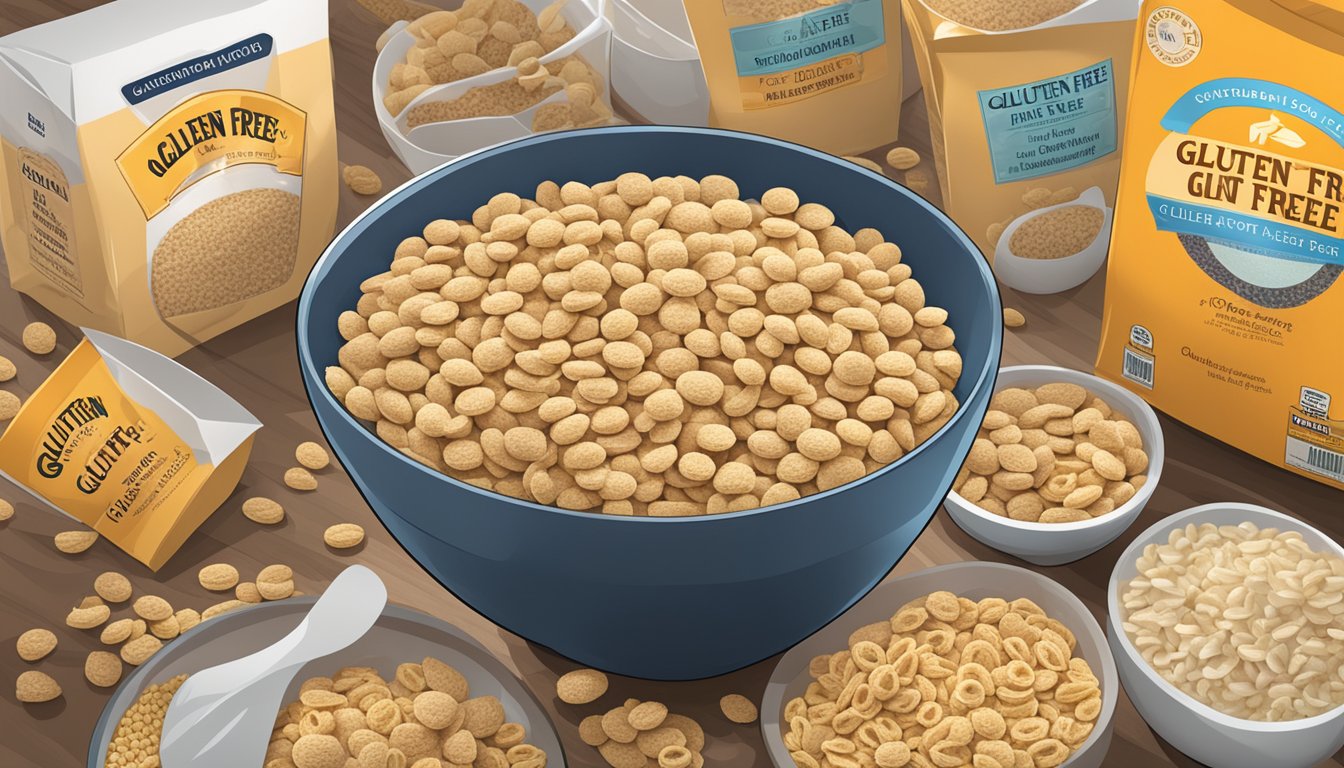Breakfast cereals are a staple in many households, but for those with celiac disease or gluten intolerance, finding suitable options can be challenging. Fortunately, numerous gluten-free cereals are now available, providing tasty and nutritious alternatives for those on a gluten-free diet.
The range of gluten-free cereals has expanded significantly in recent years. Major brands like General Mills offer gluten-free versions of popular cereals such as Cheerios and Chex. Smaller companies also produce specialty gluten-free cereals, catering to various taste preferences and dietary needs.
When selecting gluten-free cereals, it’s crucial to check labels carefully. Many manufacturers clearly mark their products as “gluten-free” to assist consumers. Some cereals may be naturally gluten-free, while others undergo special processing to remove gluten-containing ingredients. This variety ensures that individuals with celiac disease or gluten sensitivity can still enjoy a bowl of cereal as part of their morning routine.
Understanding Gluten and Celiac Disease
Gluten is a protein found in certain grains that can trigger health issues for some individuals. Celiac disease and gluten sensitivity are conditions that require careful dietary management, particularly in choosing breakfast cereals and other foods.
What is Gluten?
Gluten is a protein complex present in wheat, barley, and rye. It gives dough its elastic texture and helps bread rise during baking. Gluten is composed of two main proteins: gliadin and glutenin. These proteins are responsible for the structure and texture of many baked goods.
Gluten is found in numerous foods, including:
- Bread and pastries
- Pasta
- Cereals
- Beer and some alcoholic beverages
- Sauces and gravies
Many processed foods also contain gluten as an additive or thickening agent. This widespread presence makes it challenging for those with gluten-related disorders to avoid.
Effects of Gluten on Health
For most people, gluten is harmless. However, it can cause serious health problems for individuals with celiac disease or gluten sensitivity.
Celiac disease is an autoimmune disorder where gluten consumption triggers an immune response that damages the small intestine. This damage can lead to:
- Nutrient malabsorption
- Anemia
- Osteoporosis
- Increased risk of certain cancers
Symptoms of celiac disease may include:
- Digestive issues (diarrhea, bloating, gas)
- Fatigue
- Skin rashes
- Weight loss
- Neurological problems
Non-celiac gluten sensitivity can cause similar symptoms without intestinal damage. Both conditions require strict adherence to a gluten-free diet for symptom management.
Diagnosis of Celiac Disease and Gluten Sensitivity
Diagnosing celiac disease involves several steps:
- Blood tests to detect specific antibodies
- Genetic testing for HLA-DQ2 and HLA-DQ8 genes
- Intestinal biopsy to confirm damage to the small intestine
Patients must continue consuming gluten during testing to ensure accurate results. Gluten sensitivity is diagnosed by excluding celiac disease and wheat allergy, then observing symptom improvement on a gluten-free diet.
Early diagnosis is crucial to prevent long-term health complications. Individuals experiencing persistent digestive issues or other symptoms should consult a healthcare professional for proper evaluation and testing.
Defining Gluten-Free Cereals
Gluten-free cereals are breakfast options specifically formulated for individuals with celiac disease or gluten sensitivity. These products are made without wheat, barley, rye, or their derivatives.
Gluten-Free Labeling and Certification
The FDA requires foods labeled “gluten-free” to contain less than 20 parts per million (ppm) of gluten. Manufacturers must ensure their products meet this standard through testing and careful ingredient sourcing. Many companies go beyond this requirement by obtaining third-party certification.
Common gluten-free certifications include those from the Gluten-Free Certification Organization (GFCO) and the Celiac Support Association (CSA). These organizations have stricter standards, often requiring products to contain less than 10 ppm of gluten.
Some popular gluten-free cereals include Rice Chex, Corn Pops, and certain varieties of Cheerios. It’s crucial for consumers to check labels carefully, as formulations can change.
Importance of Certified Gluten-Free Products
Certified gluten-free products offer an extra layer of assurance for consumers with celiac disease or gluten sensitivity. These certifications indicate that the manufacturer has implemented rigorous testing and production protocols.
Certification helps prevent cross-contamination, a significant concern in food production. Many facilities process both gluten-containing and gluten-free foods, increasing the risk of unintended gluten exposure.
For individuals with severe gluten reactions, certified products can be life-changing. They allow for worry-free eating and reduce the risk of accidental gluten ingestion. Certified gluten-free cereals are particularly valuable for children, providing safe and convenient breakfast options.
Consumers should look for prominent gluten-free labels and certification symbols on cereal boxes. These indicate that the product has undergone additional scrutiny beyond standard FDA requirements.
Popular Gluten-Free Cereal Brands

Several major cereal manufacturers now offer gluten-free options. These brands have expanded their product lines to cater to consumers with celiac disease or gluten sensitivity.
General Mills and Cheerios
General Mills introduced gluten-free Cheerios in 2015. The company uses oats that are specially processed to remove stray wheat, rye, and barley. Gluten-free Cheerios varieties include Original, Honey Nut, Multi Grain, Apple Cinnamon, and Frosted.
General Mills also produces gluten-free versions of other popular cereals. Lucky Charms, Cinnamon Toast Crunch, and Cocoa Puffs are now available in gluten-free formulations.
The company uses rigorous testing to ensure their gluten-free cereals contain less than 20 parts per million of gluten.
Kellogg’s and Rice Krispies
Kellogg’s offers gluten-free Rice Krispies made from whole grain brown rice. This version differs from the original Rice Krispies, which contain malt flavoring derived from barley.
The gluten-free Rice Krispies have a slightly different taste and texture compared to the original. They are fortified with vitamins and minerals to match the nutritional profile of the classic version.
Kellogg’s also produces other gluten-free cereals, including Special K Gluten Free and various granolas.
Chex Varieties by General Mills
Chex cereals, produced by General Mills, offer numerous gluten-free options. These include:
Chex cereals are made from whole grain rice or corn. They are free from wheat and barley ingredients, making them naturally gluten-free.
General Mills ensures these varieties are processed in a way that prevents cross-contamination with gluten-containing grains.
Nature’s Path and Envirokidz
Nature’s Path is a leading producer of organic, gluten-free cereals. Their gluten-free line includes over 20 varieties, ranging from traditional flakes to granolas.
Popular Nature’s Path gluten-free cereals include:
- Mesa Sunrise Flakes
- Honey’d Corn Flakes
- Crunchy Vanilla Sunrise
The company’s Envirokidz brand offers gluten-free cereals designed for children. These include Panda Puffs, Gorilla Munch, and Koala Crisp.
Nature’s Path uses dedicated gluten-free facilities to prevent cross-contamination. They also conduct regular testing to ensure their products meet gluten-free standards.
Ingredients and Nutritional Considerations

Gluten-free cereals vary widely in their nutritional profiles. Key factors to examine include whole grain content, added sugars, and overall nutrient density.
Whole Grains and Nutritional Benefits
Many gluten-free cereals incorporate whole grains like brown rice, quinoa, and certified gluten-free oats. These provide essential nutrients such as fiber, B vitamins, and minerals. For example, a serving of quinoa-based cereal can offer 3-4 grams of protein and 2-3 grams of fiber.
Some brands fortify their products with additional vitamins and minerals to match the nutritional content of conventional cereals. This is particularly important for those with celiac disease, who may be at risk for nutrient deficiencies.
When selecting a gluten-free cereal, consumers should look for options that list whole grains as the first ingredient. This ensures a higher nutrient density and better overall nutritional value.
Sugar Content in Gluten-Free Cereals
Sugar content in gluten-free cereals can vary significantly. Some products contain as much as 12-15 grams of sugar per serving, while others have less than 1 gram.
High sugar content is often used to improve taste and texture in gluten-free products. However, excessive sugar intake can contribute to health issues such as obesity and tooth decay.
Consumers should aim for cereals with less than 6 grams of sugar per serving. Natural sweeteners like fruit purees or honey may be preferable to refined sugars.
It’s important to read nutrition labels carefully. Some cereals marketed as “healthy” may still contain high amounts of added sugars under various names such as corn syrup, dextrose, or evaporated cane juice.
Cross-Contamination and Safe Handling

Cross-contamination poses a significant risk for those following a gluten-free diet. Proper handling and awareness are crucial to avoid accidental gluten exposure in cereals and other foods.
Identifying and Avoiding Gluten Cross-Contamination
Cross-contamination can occur during storage, preparation, and cooking of gluten-free foods. Shared utensils, surfaces, and equipment are common sources of hidden gluten.
In cereal production, cross-contamination risks are particularly high. Up to 32% of products labeled gluten-free may contain trace amounts of gluten. Major recalls have occurred due to gluten contamination in cereals.
To minimize risks:
- Store gluten-free cereals separately
- Use dedicated gluten-free equipment and utensils
- Check labels carefully for potential cross-contamination warnings
- Choose certified gluten-free products when possible
Tips for Safe Gluten-Free Eating
Maintaining a safe gluten-free diet requires vigilance. When selecting breakfast cereals:
- Opt for naturally gluten-free grains like rice, corn, and quinoa
- Choose cereals specifically labeled and certified gluten-free
- Be cautious with oat-based cereals, as oats are often cross-contaminated
At home:
- Clean surfaces thoroughly before preparing gluten-free foods
- Use separate toasters and cooking oils for gluten-free items
- Educate family members about cross-contamination risks
When dining out, communicate clearly with staff about gluten-free needs and potential hidden sources of gluten in cereals and other foods.
Innovative Gluten-Free Cereal Options
The gluten-free cereal market has expanded significantly, offering diverse and nutritious options for those with celiac disease or gluten sensitivity. Innovative brands are using alternative grains, seeds, and organic ingredients to create tasty breakfast choices.
Alternative Grain and Seed Cereals
Quinoa has become a popular gluten-free cereal base. Ancient Harvest Quinoa Flakes provide a protein-rich start to the day. Maple Buckwheat Flakes offer a unique flavor profile and are packed with nutrients.
Catalina Crunch uses a blend of non-grain ingredients to create crunchy, low-carb cereals. Their flavors include chocolate, cinnamon toast, and fruity options.
Lovebird produces grain-free cereals using cassava flour and coconut. These innovative cereals are paleo-friendly and come in flavors like Cinnamon Churro and Chocolate Strawberry.
Organic and Non-GMO Cereal Selections
Many gluten-free cereals now boast organic and non-GMO certifications. Nature’s Path offers a wide range of organic, gluten-free cereals, including their popular Mesa Sunrise flakes and Qi’a superfoods cereals.
Kashi has expanded its gluten-free line with options like Indigo Morning Organic Corn Cereal. These cereals use organic blue corn and contain no artificial colors or flavors.
Cascadian Farms produces organic, gluten-free versions of classic cereals. Their Honey Vanilla Crunch provides a healthier alternative to mainstream honey-flavored cereals.
For those who prefer hot cereals, gluten-free oatmeal and Cream of Rice offer comforting breakfast options. These can be customized with various toppings for added nutrition and flavor.
Considerations for On-the-Go Snacking

Gluten-free breakfast cereals can make excellent on-the-go snacks. When choosing a cereal for snacking, opt for varieties that are easy to eat without milk and won’t create a mess.
Dry, crunchy cereals work best for portable snacking. Look for options like gluten-free granolas or crispy rice cereals that can be eaten by the handful.
Portion size is important for on-the-go eating. Consider packing single servings in small containers or resealable bags for convenience and portion control.
Some gluten-free cereals come in individual serving sizes, making them ideal for grab-and-go snacking. These pre-portioned options save time and ensure freshness.
Nutrition is key when selecting a gluten-free cereal for snacking. Choose cereals with:
- Low added sugars
- High fiber content
- Protein for satiety
Many gluten-free breakfast cereals offer a good balance of nutrients, making them a smart choice for between-meal snacking.
Remember to always check labels carefully. Some cereals may contain hidden sources of gluten or be processed in facilities that handle gluten-containing products.
For added variety, mix gluten-free cereals with dried fruits, nuts, or seeds to create a custom trail mix. This can provide extra nutrients and flavor for on-the-go snacking.
Technological Advances in Gluten Detection

Recent years have seen significant progress in developing tools for detecting gluten in food products. These advances aim to provide more accurate and accessible gluten testing methods for both consumers and food manufacturers.
At-Home Gluten Detection with Nima Sensor
The Nima Sensor represents a breakthrough in portable gluten detection technology. This compact device allows users to test small food samples for the presence of gluten in just a few minutes. It utilizes antibody-based chemistry to detect gluten proteins at levels as low as 20 parts per million.
To use the Nima Sensor, consumers insert a pea-sized food sample into a disposable capsule. The device then analyzes the sample and displays a simple “gluten found” or “gluten-free” result on its screen. This technology empowers individuals with celiac disease or gluten sensitivity to make informed decisions about their food choices when dining out or consuming packaged products.
While the Nima Sensor offers convenience, it’s important to note that it’s not a replacement for laboratory testing. Food manufacturers still rely on more comprehensive analytical methods to ensure gluten-free compliance in their production processes.




